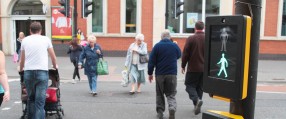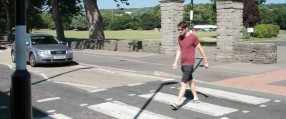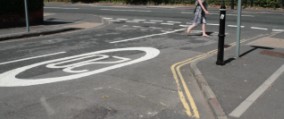Pedestrian Refuge Island
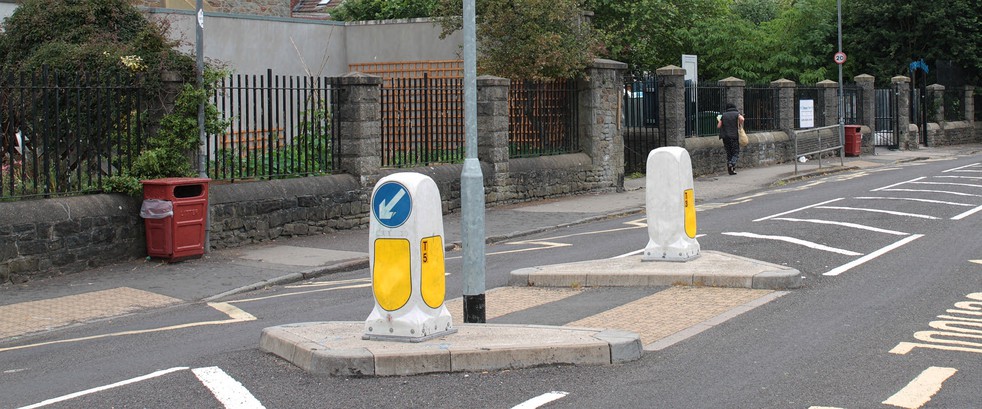
A pedestrian refuge island is a raised section of pavement between two lanes of traffic moving in opposite directions.
The Islands normally have yellow and white plastic bollards with a blue arrow to remind motorists to keep left. Kerbs are dropped at both sides of the road, usually with tactile paving where the pavement slopes towards the road.
Refuge Islands allow pedestrians to stop in the centre of the road, so they can split the crossing into two stages for each direction of traffic.
Disadvantages
- There is no pedestrian priority. Motor vehicles have priority
- Pedestrians may have to wait much longer for a gap in vehicle traffic to cross safely, compared to a zebra or puffin crossing. This will happen with heavy traffic
- For the pedestrian to cross safely, they must have good judgement of motor vehicle speeds and gaps in vehicle traffic
- Visually impaired people, or those with other disabilities may find refuge island less easy to use compared with a zebra or puffin crossing
- Some motor vehicle drivers act dangerously near crossing islands if a cyclist is passing through. They may squeeze past the cyclist when passing the crossing island, or swerve dangerously around the cyclist just before the crossing island. Cyclists can feel very uncomfortable with this behaviour
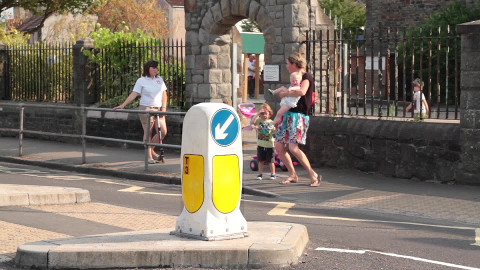
Restrictions
- Refuge islands must be a minimum of 1.2 meters wide, however this is usually raised to 1.8 meters in Bristol to accommodate pushchairs and wheelchairs more easily
- Normally, road widths must be at least 4 to 4.5 meters either side of the refuge (if the location is on a bend and large motor vehicles are expected, this must be increased)
- Parking restrictions may need to be imposed on approach and near to the refuge
- Not suitable for locations with a high volume of crossing pedestrians - Puffin crossings may be more appropriate
- Not suitable for locations with high levels of motor vehicle traffic - Zebra or Puffin crossings might be more appropriate
There's also some general restrictions to note for all schemes
Advantages
- Allows pedestrians to cross more easily than if there was no crossing
- May help to cross the road more quickly, as a gap is only required in one direction of traffic
- The cheapest crossing design, in comparison to other crossings (e.g. puffin, zebra crossings)
- Pedestrian refuges narrow the road, which may reduce the speed of vehicles
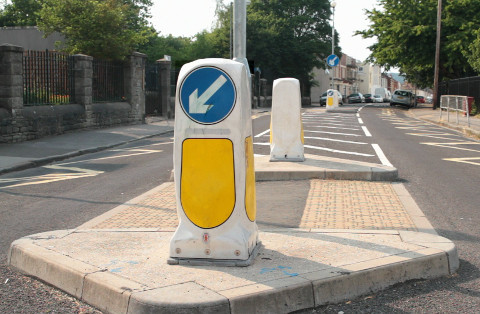
Effectiveness
Crashes
Pedestrian refuges are very effective at increasing safety for pedestrians crossing the road. On a road where pedestrians often cross without a crossing facility, a refuge will decrease pedestrian accidents by around 40%.
A pedestrian refuge allows pedestrians to cross one direction of vehicle traffic at a time. The refuge provides some protection from traffic in the centre of the road, while the pedestrian waits for a safe gap in the second direction of traffic. Without a refuge, the pedestrian needs to judge a safe gap between both directions of traffic at the same time - this is more difficult, and may increase risk.
Refuges will be safest on roads with low to medium flows of vehicle traffic, and where speeds are below 30 mph.
Speed
Pedestrian refuges slow traffic because they narrow the road, and may remind drivers that pedestrians could be crossing the road. Vehicle speeds at Pedestrian refuges reduce by 6%.
Advanced information
Crashes
Pedestrian safety figures are based on three studies into raised medians in the road; Bowman & Vecellio (1994),and Zegeer (2001) provide robust analyses from the United States. Garder (1989) provides a weaker study, but still forms a key part of the evidence base.
The study by Bowman & Vecellio examined 1,012 pedestrian accidents in 4 cities in the United States. The study established that accidents were reduced by 55% at midblock Central Business District (CBD) locations. This figure reduced to 42.3% at midblock suburban locations. The figure at suburban locations carries the most relevance for Bristol's Neighbourhood Partnerships, as the locations normally under consideration will be typically suburban.
The study by Zegeer (2001) is based on accident data from 2,000 pedestrian crossings in 30 cities. The results showed busy roads with more than 3 lanes of vehicle traffic had 40% fewer pedestrian crashes if raised medians were installed midblock. Whilst these findings are not immediately applicable to Neighbourhood Partnership areas - which would typically have lower traffic flows, and only 2 lanes of traffic - the study has a very strong methodological basis, and compliments a trend in the evidence base that raised medians reduce accidents.
Bowman & Vecellio (1994) and Garder (1989) conducted further specific research into medians at signalised junctions. Neighbourhood Partnerships may not typically intervene in these locations, however the information is included here for further indication of raised median safety effects. Using the same methodology, Bowman & Vecellio calculated raised medians reduce pedestrian accidents by 18.4% at CBD locations, and 58.2% at suburban locations. The weaker study by Garder is based in Sweden with analysis of conflicts at 120 intersections. Generally, the results indicate a 33% reduction in pedestrian accidents when a raised median is used - specifically, statistical significance was achieved when observing streets below 10m and above 15m in width, with motorised vehicle speeds above 30 kph on one arm of the junction. With slower speed speeds (below 30 kph), there was an accident reduction of 19.5%.
To reach the figure of around 40% reduction in accidents, the Bowman & Vecellio study carried the most weight as it had strong methodology and the best applicability. Other studies add context to this, and typically indicate similar safety effects of pedestrian refuge islands.
Speed
Speed at pedestrian refuges is based on a good quality simulator research study into speed reducing treatments (Jamson et al., 2010). The research specifically compared UK treatments on UK style roads. The research findings are considered to be very conservative, as the study only recruited young (19 to 25 years old) male drivers - younger drivers, and specifically young male drivers are most likely to be speeding, therefore research which is found to be effective on this group is thought to be at least equally effective on other motor vehicle users. A speed reduction of 6% may be greater across an average cross section of motor vehicle drivers.
References
Bowman, B. & Vecellio, R. (1994) Effect of Urban and Suburban Median Types on Both Vehicular and Pedestrian Safety. Transportation Research Record 1445 pp. 169 - 179
Garder, P. (1989) Pedestrian safety at traffic signals: a study carried out with the help of a traffic conflicts technique. Accident Analysis and Prevention 21 (5) pp. 435 - 444
Jamson, S., Lai, F., Jamson, H. (2010) Driving simulators for robust comparisons: A case study evaluating road safety engineering treatments. Accident Analysis and Prevention 42 pp. 961 - 971
Zegeer, C., Stewart, R., Huang, H., Lagerwey, P. (2001) Safety Effects of Marked Versus Unmarked Crosswalks at Uncontrolled Locations: Analysis of Pedestrian Crashes in 30 Cities. Transportation Research Record 1773 pp. 56 - 68
